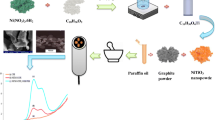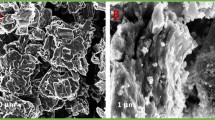Abstract
The present work reports the performance and the mechanism of detection of a voltammetric sensor for salicylic acid (SA) in a skin care product employing a carbon nanotube/iron oxide nanoparticle (SWCNT/ION) modified electrode. The coupling between Fe(III) → Fe(II) and SA → SA (radical) half-cell reactions at the surface of SWCNT/ION and the enlarged surface area are harnessed to enhance the sensor’s sensitivity. By means of differential pulse voltammetry under optimized conditions, the performance of the (SWCNT/ION) provided the following figure of merit: two linear working ranges 0.6–2.9 μmol/L (r2 = 0.996) and 2.9–46.3 μmol/L (r2 = 0.995), sensitivity 0.64 μA cm−2/μmol L−1, limit of detection (LOD) (3Sb/b) 0.02 μmol/L, and limit of quantification (10Sb/b) 0.07 μmol/L. The LOD is lower than most of the electroanalytical methodologies found in the literature. The determination of SA in a skin care product shows no difference, at 95% confidence level (Student’s t test), to that performed with HPLC/UV-Vis. Moreover, a single modified electrode can be used for at least 18 consecutive runs while losing less than 10% of its sensitivity. The sensitivity difference between electrodes made in different batches is only 5.4%.





Similar content being viewed by others
References
Duthie GG, Wood AD (2011) Natural salicylates: foods, functions and disease prevention. Food Funct 2(9):515–520
Pulgarín JAM, Molina AA, Robles IS (2011) Simultaneous determination of salicylic acid and salicylamide in biological fluids. Spectrochim Acta A 79(5):909–914
Chocholouš P, Holík P, Šatínský D, Solich P (2007) A novel application of onyx™ monolithic column for simultaneous determination of salicylic acid and triamcinolone acetonide by sequential injection chromatography. Talanta 72(2):854–858
Madan RK, Levitt J (2014) A review of toxicity from topical salicylic acid preparations. J Am Dermatol 70(4):788–792
Youssef RM, Korany MA, Afify MA (2014) Development of a stability indicating HPLC-DAD method for the simultaneous determination of mometsone furoate and salicylic acid in an ointment matrix. Anal Methods 6(10):3410–3419
Ruiz-Medina A, Cordóva MLF, Ortega-Barrales P, Molina-Díaz A (2001) Flow-through UV spectrophotometric sensor for determination of (acetyl)salicylic acid in pharmaceutical preparations. Int J Pharm 216(1-2):95–104
Eksi-Kocak H, Tamer SI, Yilmaz S, Eryilmaz M, Boyaci IH, Tamer U (2018) Quantification and spatial distribution of salicylic acid in film tablets using FT-Raman mapping with multivariate curve resolution. Asian J Pharm Sci 13(2):155–162
Huang Z, Wang Z, Shi B, Wei D, Chen J, Wang S, Gao B (2015) Simultaneous determination of salicylic acid, jasmonic acid, methyl salicylate, and methyl jasmonate from Ulmus pumila leaves by GC-MS. Int J Anal Chem 2015:1–7
Silva GS, Lima DLD, Esteves VI (2017) Salicylic acid determination in estuarine and riverine waters using hollow fiber liquid-phase microextraction and capillary zone electrophoresis. Environ Sci Pollut Res 24(18):15748–15755
Sivula K, Formal FL, Grätzel M (2011) Solar water splitting : Progress using hematite (α-Fe2 O3) Photoelectrodes. ChemSusChem 4(4):432–449
Wang D, Li Y, Wang Q, Wang T (2012) Nanostructured Fe2O3 – graphene composite as a novel electrode material for supercapacitors. J Solid State Electrochem 16(6):2095–2102
Yin H, Zhou Y, Liu T, Tang T, Ai S, Zhu L (2012) Determination aminopyrine in pharmaceutical formulations based on APTS-Fe3O4 nanoparticles modified glassy carbon electrode. J Solid State Electrochem 16(2):731–738
Chumming J, Xiangqin L (2009) Electrochemical synthesis of Fe3O4-PB nanoparticles with core-shell structure and its electrocatalytic reduction toward H2O2. J Solid State Electrochem 13(8):1273–1278
Hu Y, Zhang Z, Zhang H, Luo L, Yao S (2012) Selective and sensitive molecularly imprinted sol–gel film-based electrochemical sensor combining mercaptoacetic acid-modified PbS nanoparticles with Fe3O4 @ au–multi-walled carbon nanotubes–chitosan. J Solid State Electrochem 16(3):857–867
Alizadeh T, Jamshidi F (2015) Synthesis of nanosized sulfate-modified α-Fe2O3 and its use for the fabrication of all-solid-state carbon paste pH sensor. J Solid State Electrochem 19(4):1053–1062
Ramos JA, Fernandes EGR, Zucolotto V (2015) A peroxidase biomimetic system based on Fe3O4 nanoparticles in non-enzymatic sensors. Talanta 141:307–314
Wang Y, Zhang H, Yao D, Pu J, Zhang Y, Gao X, Sun Y (2013) Direct electrochemistry of hemoglobin on graphene/Fe3O4 nanocomposite-modified glass carbon electrode and its sensitive detection for hydrogen peroxide. J Solid State Electrochem 7:881–887
Yang S, Li G, Wang G, Deng D, Qu L (2015) A novel electrochemical sensor based on Fe2O3 nanoparticles/N-doped graphene for electrocatalytic oxidation of L-cysteine. J Solid State Electrochem 19(12):3613–3620
Wang X, You Z, Sha H, Sun Z, Sun W (2014) Electrochemical myoglobin biosensor based on carbon ionic liquid electrode modified with Fe3O4@SiO2 microsphere. J Solid State Electrochem 18(1):207–213
Zhang W, Wang L, Zheng X (2014) Indicator-free electrochemical genosensing originated from the self-signal of poly-xanthurenic acid enhanced by Fe3O4/reduced graphene oxide. J Solid State Electrochem 18(9):2367–2373
Mahendran V, Philip J (2013) Sensing of biologically important cations such as Na+, K+, Ca2+, Cu2+, and Fe3+ using magnetic nanoemulsions. Langmuir 29(13):4252–4258
Zhao G, Xu JJ, Chen HY (2006) Fabrication, characterization of Fe3O4 multilayer film and its application in promoting direct electron transfer of hemoglobin. Electrochem Commun 8(1):148–154
Belle CJ, Bonamin A, Simon U, Santoyo-Salazar J, Pauly M, Bégin-Colin S, Pourroy G (2011) Size dependent gas sensing properties of spinel iron oxide nanoparticles. Sensors Actuators B 160(1):942–950
Singh V, Kaul S, Singla P, Kumar V, Sandhir R, Chung JH, Garg P, Singhal NK (2018) Xylanase immobilization on magnetite and magnetite core/shell nanocomposites using two different flexible alkyl length organophosphonates: linker length and shell effect on enzyme catalytic activity. Int J Biol Macromol 115:590–599
Oliveira TR, Martucci DH, Faria RC (2018) Simple disposable microfluidic device for Salmonella typhimurium detection by magneto-immunoassay. Sensors Actuators B 255:684–691
Costa MP, Andrade CAS, Montenegro RA, Melo FL, Oliveira MDL (2014) Self-assembled monolayers of mercaptobenzoic acid and magnetite nanoparticles as an efficient support for development of tuberculosis genosensor. J Colloid Interface Sci 433:141–148
Baby TT, Ramaprabhu S (2010) SiO2 coated Fe3O4 magnetic nanoparticle dispersed multiwalled carbon nanotubes based amperometric glucose biosensor. Talanta 80(5):2016–2022
Kaushik A, Solanki PR, Ansari AA, Sumana G, Ahmad S, Malhotra BD (2009) Iron oxide-chitosan nanobiocomposite for urea sensor. Sensors Actuators B 138(2):572–580
Santos JGM, Souza JR, Letti CJ, Soler MAG, Morais PC, Pereira-da-Silva MA, Paterno LG (2014) Iron oxide nanostructured electrodes for detection of copper ( II ) ions. J Nanosci Nanotechnol 14(9):6614–6623
Adekunle AS, Agboola BO, Pillay J, Ozoemena KI (2010) Chemical Electrocatalytic detection of dopamine at single-walled carbon nanotubes–iron ( III ) oxide nanoparticles platform. Sensors Actuators B 148(1):93–102
Sun L, Feng Q, Yan Y, Pan Z, Li X, Song F, Yang H, Xu J, Bao N, Gu H (2014) Paper-based electroanalytical devices for in situ determination of salicylic acid in living tomato leaves. Biosens Bioelectron 60:154–160
Zhang W, Xu B, Hong Y, Yu Y, Ye J, Zhang J (2010) Electrochemical oxidation of salicylic acid at well-aligned multiwalled carbon nanotube electrode and its detection. J Solid State Electrochem 14(9):1713–1718
Lu S, Bai L, Wen Y, Li M, Yan D, Zhang R, Chen K (2015) Water-dispersed carboxymethyl cellulose-montmorillonite-single walled carbon nanotube composite with enhanced sensing performance for simultaneous voltammetric determination of two trace phytohormones. J Solid State Electrochem 19(7):2023–2037
Ribeiro CL, Santos JGM, Souza JR, Pereira-da-Silva MA, Paterno LG (2017) Electrochemical oxidation of salicylic acid at ITO substrates modified with layer-by-layer films of carbon nanotubes and iron oxide nanoparticles. J Electroanal Chem 805:53–59
Lobo RFM, Pereira da Silva MA, Raposo M, Faria RM, ONJr O (1999) In situ thickness measurements of ultra-thin multilayer polymer films by atomic force microscopy. Nanotechnology 10(4):389–393
Kang YS, Risbud S, Rabolt JF, Stroeve P (1996) Synthesis and characterization of nanometer-size Fe3O4 and γ-Fe2O3 particles. Chem Mater 8(9):2209–2211
Cornell RM, Schwertmann U (2003) The Iron Oxides: Structure, Properties, Reactions, Occurences and Uses. Wiley-VCH, Germany
Torriero AAJ, Luco JM, Sereno L, Raba J (2004) Voltammetric determination of salicylic acid in pharmaceuticals formulations of acetylsalicylic acid. Talanta 62:247–254
Park J, Eun C (2016) Electrochemical behavior and determination of salicylic acid at carbon-fiber electrodes. Electrochim Acta 194:346–356
Chrzescijanska E, Wudarska E, Kusmierek E, Rynkowski J (2014) Study of acetylsalicylic acid electroreduction behavior at platinum electrode. J Electroanal Chem 713:17–21
Wang C, Shen M, Ding Y, Zhao D, Cui S, Li L (2017) Facile preparation of multilayer ultrathin films based on eriochrome black T/NiAl-layered double hydroxide nanosheet, characterization and application in amperometric detection of salicylic acid. J Electroanal Chem 785:131–137
Pletcher D, Greff R, Peat R, Peter LM, Robinson J (2010) Instrumental methods in electrochemistry. Woodhead Publishing, Cambridge
ICH Topic Q2 (R1) (2005) Validation of analytical procedures: text and methodology. Int Conf Harmon 1994(2005):17
Fisher FA, Yates F (1938) Statistical tables for biological, agricultural and medical research. Longman Group Ltd, Oxford
Doulache M, Benchettara A, Trari M (2014) Detection of salicylic acid by electrocatalytic oxidation at a nickel-modified glassy carbon electrode. J Anal Chem 69(1):51–56
Sun L, Pan Z, Xie J, Liu X, Sun F, Song F, Bao N, Gu H (2013) Electrocatalytic activity of salicylic acid on au@Fe3O4 nanocomposites modified electrode and its detection in tomato leaves infected with Botrytis cinereal. J Electroanal Chem 706:127–132
Ghoreishi SM, Kashani FZ, Khoobi A, Enhessari M (2015) Fabrication of a nickel titanate nanoceramic modified electrode for electrochemical studies and detection of salicylic acid. J Mol Liq 211:970–980
Lu L, Zhu X, Qiu X, He H, Xu J, Wang X (2014) Graphene oxide/multiwalled carbon nanotubes composites as an enhanced sensing platform for voltammetric determination of salicylic acid. Int J Electrochem Sci 9:8057–8066
Alizadeh T, Nayeri S (2018) Electrocatalytic oxidation of salicylic acid at a carbon paste electrode impregnated with cerium-doped zirconium oxide nanoparticles as a new sensing approach for salicylic acid determination. J Solid State Electrochem 22(7):2039–2048
Rawlinson S, McLister A, Kanyong P, Davis J (2018) Rapid determination of salicylic acid at screen printed electrodes. Microchem J 137:71–77
Ganjali MR, Nejad FG, Tajik S, Beitollahi H, Pourbasheer E, Larijanii B (2017) Determination of salicylic acid by differential pulse voltammetry using ZnO/Al2O3 nanocomposite modified graphite screen printed electrode. Int J Electrochem Sci 12:9972–9982
Zhao C, Lin J (2017) Electrochemically reduced graphene oxide modified screen- printed electrodes for sensitive determination of acetylsalicylic acid. Int J Electrochem Sci 12:10177–10186
Derikvand H, Azadbakht A (2017) An impedimetric sensor comprising magnetic nanoparticles-graphene oxide and carbon nanotube for the electrocatalytic oxidation of salicylic acid. J Inorg Organomet Polym 27(4):901–911
Sivakumar M, Sakthivel M, Chen S, Veerakumar P, Liu S (2017) Sol-gel synthesis of carbon-coated LaCoO3 for effective electrocatalytic oxidation of salicylic acid. ChemElectroChem 4(4):935–940
Acknowledgements
The authors thank the support of Dr. Marcelo A. Pereira-da-Silva (IFSC-USP) with atomic force microscopy and Professor Maria A. G. Soler (IF-UnB) with Raman spectroscopy.
Funding
Financial support was given by Brazilian funding agencies CNPq and FAP-DF (process no. 0193.000829/2015) and FINEP (process no. 01/13/0470/00). This study was financed in part by the Coordenação de Aperfeiçoamento de Pessoal de Nível Superior - Brasil (CAPES) - Finance Code 001.
Author information
Authors and Affiliations
Corresponding author
Additional information
Publisher’s Note
Springer Nature remains neutral with regard to jurisdictional claims in published maps and institutional affiliations.
Electronic supplementary material
ESM 1
(PDF 235 kb)
Rights and permissions
About this article
Cite this article
Ribeiro, C.L., Santos, J.G.M., Souza, J.R. et al. Highly sensitive determination of salicylic acid in skin care product by means of carbon nanotube/iron oxide nanoparticle voltammetric sensors. J Solid State Electrochem 23, 783–793 (2019). https://doi.org/10.1007/s10008-018-04189-y
Received:
Revised:
Accepted:
Published:
Issue Date:
DOI: https://doi.org/10.1007/s10008-018-04189-y




